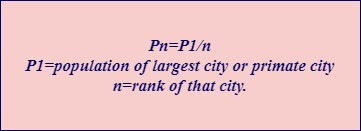It is the concept of explaining the hierarchy of urban settlement at a place. The population of urban settlements (towns, cities) will be inversely proportional to the rank in the urban Hierarchy. That means a larger population has a smaller rank in the urban hierarchy. The pattern of the rank-size rule was created by George Zips in 1949, it is also known as Zipf's law.
Australia follows the rank-size rule to some extend:
What is Zipf rank-size rule?
As per Zipf, if the urban settlements of a country or a place are organized in descending order of population, the population of the nth city will be 1/n of the largest city.
 |
| Zipf rank-size rule |
The ideal example of rank-size hierarchy would be the following if the population of the largest city is 1000
- Then the population of the 2nd city will be=1000/2=500
- The population of 3rd city will be=1000/3=333
- The population of the 10th city will be =1000/10=100
Where the rank-size rule is found?
- A larger area-wise country such as the USA, Australia, or Russia.
- Most economically advanced countries
- Countries have long urban histories & complex social & economic histories.
- The rank-size rule generally applies to those cities that do not have primate cities. As the concept of a primate city is not proportional.
Rank size rule in the USA:
- Ist Rank City:
- New York- 8.3 million population
- 2nd rank City:
- Los Angeles-4.1 Million population
- 3rd rank city:
- Chicago-2.9 Million population
- 4th rank city:
- Houston-2.3 Million population
Australia follows the rank-size rule to some extend:
- 1 rank city:
- Sydney
- No 2 rank city
- Melbourne ( approx same the Sydney population)
- 3rd rank city:
- Brisbane ( 1/3rd of Sydney population)
- 4th rank city:
- Perth( 1/4th of Sydney's population)
India and China do not follow the rank-size rule in urban settlements.
Primate city Vs Rank Size rule
- Primate city shows the early stage of development while the rank-size rule pattern shows the advanced stage of development.
- Primate city found in generally least developed countries or developed counties with small territory extends, while the Rank size rule pattern is found in most developed countries with large territorial extends.
- Primate city shows the unequal development status of the countries where rank-size rule patterns of cities show some equality in development patterns.
Try to solve the following questions:
- Discuss the concept of "Rank-Size-Rule" given by G.K.Zipf. Is this rule relevant in the Indian context? ( UPSC 2022, 15 marks)


1 Comments:
Click here for Commentsthankyou
ConversionConversion EmoticonEmoticon